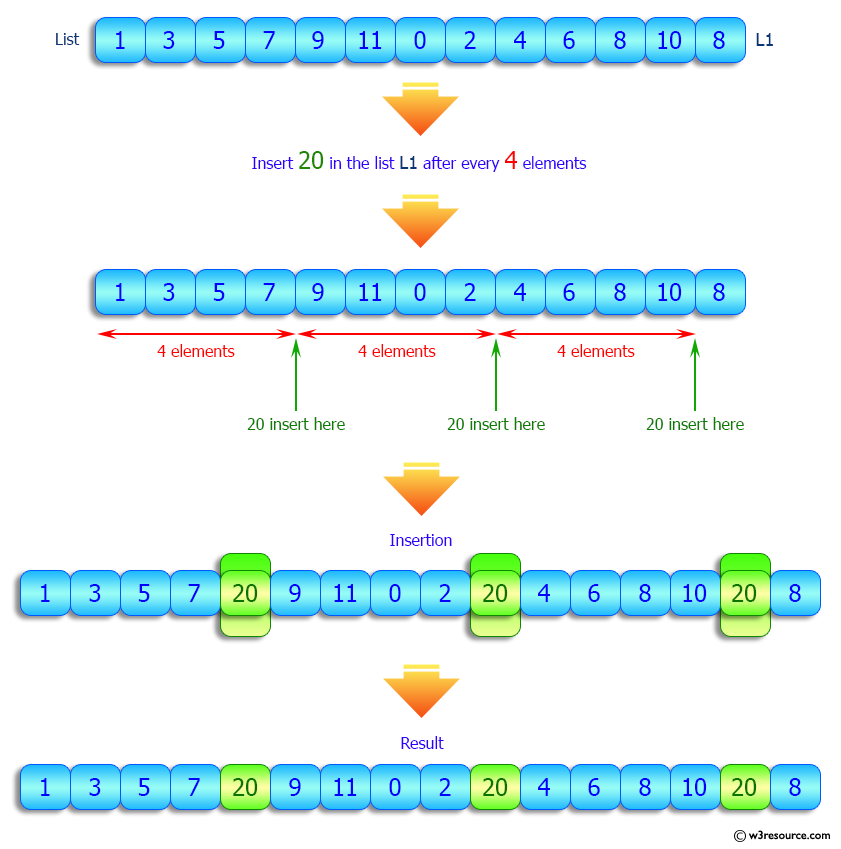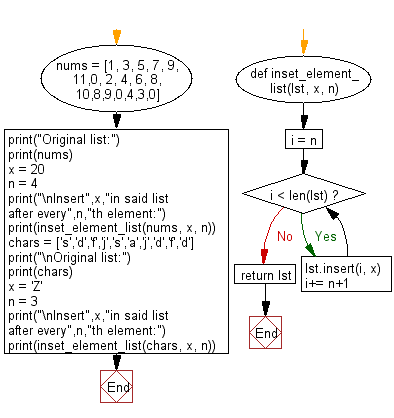Python: Insert a specified element in a given list after every nth element
Insert Element After Every Nth Position
Write a Python program to insert a specified element in a given list after every nth element.
Visual Presentation:

Sample Solution:
Python Code:
# Define a function called 'inset_element_list' that inserts an element 'x' into a list 'lst' after every 'n' elements.
def inset_element_list(lst, x, n):
# Initialize a variable 'i' with the value of 'n'.
i = n
# Use a 'while' loop to iterate through the list 'lst'.
while i < len(lst):
# Insert the element 'x' at index 'i' in the list.
lst.insert(i, x)
# Increment 'i' by 'n+1' to skip 'n' elements and insert 'x' again after 'n' elements.
i += n + 1
# Return the modified list 'lst'.
return lst
# Create a list of integers 'nums'.
nums = [1, 3, 5, 7, 9, 11, 0, 2, 4, 6, 8, 10, 8, 9, 0, 4, 3, 0]
# Print a message indicating the original list of integers.
print("Original list:")
print(nums)
# Define the element 'x' and the interval 'n' for inserting into the list.
x = 20
n = 4
# Print a message indicating the element to be inserted and the interval.
print("\nInsert", x, "in the said list after every", n, "th element:")
# Call the 'inset_element_list' function to insert 'x' into the list 'nums' after every 'n' elements and print the result.
print(inset_element_list(nums, x, n))
# Create a list of characters 'chars'.
chars = ['s', 'd', 'f', 'j', 's', 'a', 'j', 'd', 'f', 'd']
# Print a message indicating the original list of characters.
print("\nOriginal list:")
print(chars)
# Define the element 'x' and the interval 'n' for inserting into the list.
x = 'Z'
n = 3
# Print a message indicating the element to be inserted and the interval.
print("\nInsert", x, "in said list after every", n, "th element:")
# Call the 'inset_element_list' function to insert 'x' into the list 'chars' after every 'n' elements and print the result.
print(inset_element_list(chars, x, n))
Sample Output:
Original list: [1, 3, 5, 7, 9, 11, 0, 2, 4, 6, 8, 10, 8, 9, 0, 4, 3, 0] Insert 20 in said list after every 4 th element: [1, 3, 5, 7, 20, 9, 11, 0, 2, 20, 4, 6, 8, 10, 20, 8, 9, 0, 4, 20, 3, 0] Original list: ['s', 'd', 'f', 'j', 's', 'a', 'j', 'd', 'f', 'd'] Insert Z in said list after every 3 th element: ['s', 'd', 'f', 'Z', 'j', 's', 'a', 'Z', 'j', 'd', 'f', 'Z', 'd']
Flowchart:

For more Practice: Solve these Related Problems:
- Write a Python program to insert a specified element after every nth element in a list, skipping positions where it already exists.
- Write a Python program to cyclically insert different elements after every nth position in a list.
- Write a Python program to insert a specified element after every nth element only if the preceding element is even.
- Write a Python program to insert a specified element after every nth position in a list and then reverse the entire list.
Python Code Editor:
Previous: Write a Python program to find common elements in a given list of lists.
Next: Write a Python program to create the largest possible number using the elements of a given list of positive integers.
What is the difficulty level of this exercise?
Test your Programming skills with w3resource's quiz.
